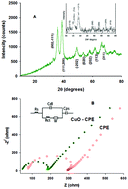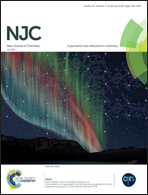Construction of a sensitive non-enzymatic fructose carbon paste electrode – CuO nanoflower: designing the experiments by response surface methodology†
Abstract
CuO nano-flowers were synthesized and used to modify a carbon paste electrode (CPE) for voltammetric determination of fructose. The samples were characterized by XRD, SEM-EDX, electrochemical impedance spectroscopy (EIS), and TEM techniques. Based on the EIS results, modification of CPE with CuO nano-flowers significantly increased the charge transfer in the electrode. The interaction effects of experimental variables on the voltammetric response of the modified electrode were studied by designing the experiments. Response surface methodology (RSM) was used for this goal. The best response was obtained in a run that included 25% CuO modifier, pH 3.3, amplitude 150 mV, step potential 10 mV, and a frequency of 15 Hz. Under optimum conditions, the electrocatalytic response of the CuO-CPE electrode was linearly proportional to fructose concentration in the range from 6 to 3000 μmol L−1 fructose, with a detection limit of 0.07 μmol L−1. The modified electrode showed good applicability in the determination of fructose in some selected real samples.



 Please wait while we load your content...
Please wait while we load your content...